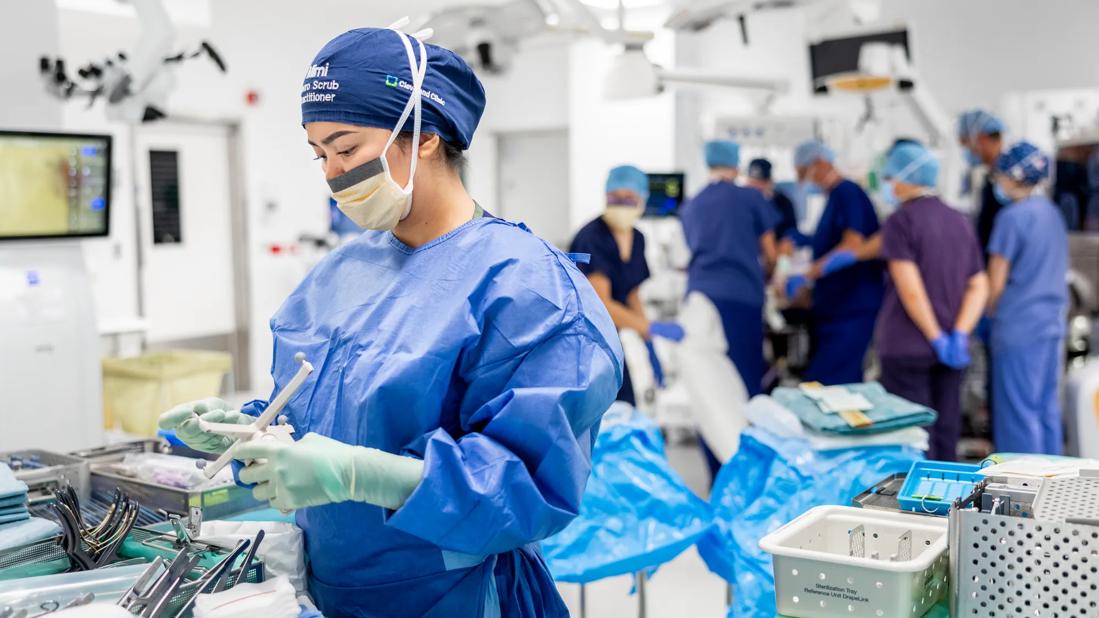Developing the perioperative caregivers of the future

In 1949, a small cohort of operating room (OR) supervisors from New York City discussed the need to pool their surgical knowledge and encourage the exchange of clinical ideas. The prescient conversation soon led to the creation of the Association of Operating Room Nurses (AORN) – and the development of perioperative nursing as a formal healthcare specialty.
Advertisement
Cleveland Clinic is a non-profit academic medical center. Advertising on our site helps support our mission. We do not endorse non-Cleveland Clinic products or services. Policy
Since then, the need for surgical nurses has increased exponentially, as have advances in technology, science and medicine. In this Q&A, Carol Pehotsky, DNP, RN, NEA-BC, ACNS-BC, CPAN, Associate Chief Nursing Officer of Surgical, Procedural and Dialysis Services for Cleveland Clinic, shares the leadership strategies that can have a game-changing effect on the future of this indispensable specialty.
Q: What keeps most surgical nurse leaders up at night?
A: Although we have come a long way in a few short years, healthcare is still faced with a shortage of perioperative nurses. Going into the COVID-19 pandemic, we knew that perioperative nursing was one of the fastest-aging subsets within the nursing profession. Unfortunately, that problem has only escalated since 2020. Once a tenured perioperative nurse retires, there’s a 7- to 15-year vacuum in which very few experienced caregivers are available to take their place.
Great work has been done to expose nursing students to the OR environment, but we must seize the opportunity to teach caregivers of all educational and professional backgrounds about the great care perioperative nurses provide. We must keep leaning into the value proposition our departments and organizations can bring to the newly hired preop, OR, procedural or PACU nurse.
Despite nationwide staffing challenges, there has never been a better time to be a perioperative nurse. More growth opportunities than ever before are available in nursing leadership, education and quality. There are countless ways to learn across surgical specialties and the perioperative spectrum, but we’ve got to make them more accessible.
Advertisement
Q: What can healthcare leaders do to help overcome the shortage of perioperative nurses?
A: Simply put, we need to hire proactively while continually working to recruit, retain and develop high-quality caregivers. I remind leaders that they must understand how many perioperative nurses and surgical technologists leave their organization each year – and fill those voids in advance. Even if the personnel offset is expected six months from now, I suggest hiring good candidates now.
At Cleveland Clinic, we work collaboratively with our colleagues in Talent Acquisition to assess interest and talent across our Ohio and Florida markets. This allows us to better collaborate and hire caregivers based on the qualities that are most important to our institution. Nurses who choose to work in the surgical setting need to be detail-oriented, energetic, technologically savvy and flexible – essential qualities for caregivers who must react to unanticipated emergencies every day.
We’ve found that the sooner inexperienced nurses are exposed to in-person instruction, the sooner they’ll discover if the perioperative field is right for them. Surgical nursing is all about providing care for a very brief period of time – and often while the patient is under anesthesia. Those who choose the specialty understand that although they may not get a chance to interact with patients very often, they are fulfilling a dynamic, critical role. They know that it’s an amazing gift to be part of peoples’ lives when they are so vulnerable.
Advertisement
In addition, we continue to refine our staffing model to ensure our nursing teams reflect Cleveland Clinic’s needs and reduce the number of call shifts needed to provide continuous evening and overnight patient care. Furthermore, we factor in data-driven variables like the type, length and complexity of our cases with the aim of customizing the staffing model for our ORs, PACUs and ambulatory surgery centers.
Q: What strategies should perioperative nurse leaders implement to better build their future surgical nursing pipelines?
A: Focus on early education and training! One of Cleveland Clinic’s most successful strategies has been the implementation of a six-month Perioperative Nurse Residency that is tailored to the experience level of each new hire.
The program, which includes time in the classroom, simulation lab and live surgical suites, provides trainees with the full support of an organization-wide nursing cohort – caregivers who have all taken a similar educational journey.
Another successful strategy has been our Perioperative Nurse Associate program, a 10-week externship for nurses entering their senior year of nursing school. The initiative allows trainees to work with experienced RNs and techs to learn the unique tasks and skills required of perioperative nurses.
Finally, I think it’s critical for perioperative nurses to learn how to circulate and scrub. Virtually every healthcare institution feels pressure to move nurses from the hiring phase to independent practice very quickly, but time spent learning both skillsets will reap long-term rewards.
Advertisement
There is great advantage to providing all newly hired nurses with fundamental scrubbing techniques; over time, those skills can be honed even further. Our nurse residents frequently say that their knowledge of scrubbing adds flexibility to their career and increases their confidence in the circulating role.
Advertisement
Advertisement

Ideation session generates solutions to medication administration errors

Caregivers spearhead changes that improve patient care, shape hospital culture

Building a culture that supports, engages and empowers nursing staff

Nurses harness cutting-edge technology as a bridge to healing

Dedicated leader shares her passion for quality, education and professional development

Optimizing care while protecting patients from life-threatening reactions

Palliative nurses improve quality of life

Care managers ensure patients return home to recuperate with the right support